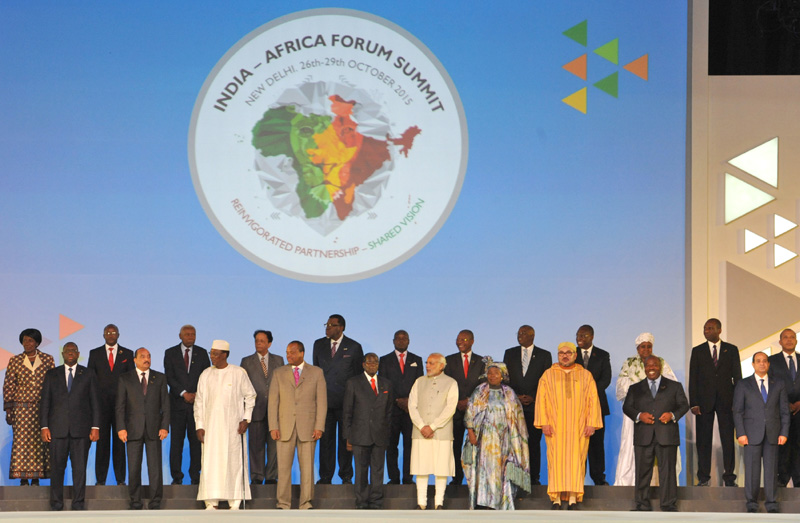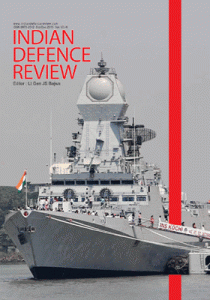IDR Blog
Post Africa Summit: India must focus on implementation

The Prime Minister Narendra Modi and the Leaders of African nations in the Family Photograph, at the inaugural ceremony of the 3rd India Africa Forum Summit 2015, in New Delhi on October 29, 2015.
The third India-Africa Forum Summit (IAFS) was undoubtedly the biggest diplomatic event hosted by India in the recent times. The summit stood out in many ways. Unlike previous summits which adhered to the Banjul Principle, all 54 African countries participated in the summit. This made the summit much more inclusive and democratic.
Africa’s importance in the world economy has increased tremendously in the last decade and many other countries are trying to develop closer ties with Africa.
The summit was also marked by a greater emphasis on India-Africa cooperation in the global fora over UN reforms, climate change and WTO negotiations. India also made some important announcements – an additional credit line of US$ 10 billion, grant assistance of US$ 600 million, and 50,000 scholarships for African students. The Delhi Declaration clearly laid out the areas of cooperation between India and Africa: trade and industry, infrastructure, energy, education and skill development, and health etc.
The summit was largely described as a success in the national and international media. But there is a need to situate India-Africa relations in a broader context. Africa’s importance in the world economy has increased tremendously in the last decade and many other countries are trying to develop closer ties with Africa.
IAFS is by no means the only major international initiative to court African countries. United States, European Union, and Turkey held Africa summits in 2014. More importantly, China, which has dramatically increased its economic footprint in Africa, will hold the sixth Forum for China-Africa Cooperation Summit (FOCAC) in December 2015. Japan and South Korea have also planned Africa summits in 2016. Therefore, there is a need for a more critical assessment of India’s economic initiatives in Africa.
Despite the fact that the Prime Minister described India and Africa as ‘two bright spots of hope and opportunities in the world economy’, the economic potential of the relationship between India and Africa has not been fully exploited.
Although bilateral trade between India and Africa has increased from a mere US$ 4.5 billion in 1996-97 to US$ 72 billion in 2014-15, it is still much below China’s trade with Africa which stands at about US$ 200 billion.
Although bilateral trade between India and Africa has increased from a mere US$ 4.5 billion in 1996-97 to US$ 72 billion in 2014-15, it is still much below China’s trade with Africa which stands at about US$ 200 billion. India’s trade with Africa is concentrated in a few countries such as Nigeria, Angola, South Africa, and Tanzania and petroleum products account for the bulk of the trade. India’s foreign direct investment in Africa has also escalated but much of it is directed to Mauritius due to its favourable tax treaty with India.
India has extended its Duty Free Tariff Preference (DFTP) Scheme to 98% of the tariff lines but this scheme has not been very successful in increasing Africa’s exports to India. Only 23 African countries out of 34 eligible countries have applied for participation in the scheme. Apart from Tanzania, no other African country has seen an increase in its exports to India under this scheme.
India continues to be an insignificant export destination for many African countries such as Uganda, which are beneficiaries under the scheme. Most of the African least developed countries find it difficult to obtain certificates of origin and face difficulties in guaranteeing that their sanitary and phytosanitary certificates comply with Indian requirements.
India’s private sector has also failed to recognise the benefits of this scheme. Indian companies would gain by setting up units in African countries and exporting to India under the DFTP scheme. Moreover, Africa could be a gateway for exports to developed country markets because African countries have zero duty access to all major markets of the world whereas India has lost its preferential status in many commodities such as textiles.
The India-Africa Business Council meet, held in the backdrop of IAFS, also stressed the need for African countries to learn from India’s experience in public-private partnerships in infrastructure development.
While the announcement of additional credit lines for Africa is a positive development, it is also important to draw lessons from the past. India had offered credit lines worth $7.4 billion to African nations over the first two India-Africa summits but only US$ 3.5 billion were disbursed to implement 137 projects in 41 nations by 2015. Again, the delays were largely due to poor African capacity in producing detailed project reports and feasibility studies which are essential for loan disbursals.
Given that shortage of infrastructure is one of the major impediments to economic development in Africa, infrastructure development is the top most priority of all African countries. Indian credit lines to African countries are typically directed to infrastructure projects such as roads, power transmission lines, farm mechanisation, and water supply etc. Most of these infrastructure projects are implemented by Indian companies under EPC contracts. But now African countries are increasingly looking at public-private partnerships as a viable option.
The India-Africa Business Council meet, held in the backdrop of IAFS, also stressed the need for African countries to learn from India’s experience in public-private partnerships in infrastructure development. However, public-private partnerships may not be very successful in Africa at this juncture. The African countries, many of which are adversely affected by falling commodity prices, may not be able to ensure adequate returns to the private sector. In fact, India’s own experience with public-private partnerships does not inspire much confidence.
India’s banking sector is reeling under the pressure of infrastructure loans. Moreover, corporate India’s debt equity ratio is one of the worst in the world. As a result, Indian construction companies are also less likely to invest in self-financed projects in Africa. They will more likely continue to focus on projects which are financed by national budgets, multilateral funding sources or EXIM Bank’s credit lines because of higher returns and lower risk.
In a nutshell, the India-Africa Summit is a feather in the cap of India’s Ministry of External Affairs but to expand its economic ties with Africa, India needs to focus on implementation. Towards that end, the announcement of a formal monitoring mechanism to review the progress of the Framework of Strategic Cooperation between India and Africa in a time bound manner is a positive development.
In order to ensure that Africa’s least developed countries benefit from DFTP, India should try to help African exporters comply with Indian standards. Addressing capacity related issues in Africa will also help to improve the disbursal rate of Indian credit lines. Lastly, the Indian private sector should also shed its tepid attitude towards Africa to realise the economic gains that Africa has to offer.
Courtesy: http://southasiamonitor.org/detail.php?type=sl&nid=14612





